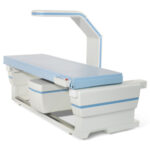Key Facts
- DXA stands for “Dual-energy X-ray Absorptiometry.”
- The DXA scan is a safe method used to measure bone density (how solid your bones are).
- The DXA scan doesn’t hurt, it’s just like an x-ray.
 DXA stands for “Dual–energy X–ray Absorptiometry.” It’s the most widely used method to measure bone density (how solid your bones are) and to see if your bones are thinning. Two x-ray beams, each with different levels of energy, are directed at your bones. The amount of energy absorbed by the bones indicates bone density.
DXA stands for “Dual–energy X–ray Absorptiometry.” It’s the most widely used method to measure bone density (how solid your bones are) and to see if your bones are thinning. Two x-ray beams, each with different levels of energy, are directed at your bones. The amount of energy absorbed by the bones indicates bone density.
Does a DXA scan hurt?
The test doesn’t hurt and it is safe. There are no shots or medicines to take. The machine is open, which means you will not be enclosed in the machine. Each scan takes about 1-6 minutes.
How should I prepare for the DXA scan?
- Appointments are usually scheduled at least 14 days after having any procedure that involves contrast materials (for example, a CT Scan with contrast dye).
- Do NOT eat foods high in calcium for 3-4 hours before your DXA scan. These foods include: milk, cheese, yogurt, and dark green leafy vegetables.
- Do NOT take calcium supplements, vitamins, or TUMS® on the day of your scan.
- Don’twear clothes (or undergarments) that have metal buttons, hooks, snaps, or zippers because metal interferes with this test. Remove jewelry and piercings when possible. If your clothing has metal on it, you will be given a hospital gown to change into.
- Remove any jewelry and piercings and leave them at home. If you can’t remove a piercing near the scan site, tell your provider when you first arrive to your appointment.
- You may drink water and other CLEAR liquids before the scan.
- Take any regular medicine well before the exam (if your health care provider agrees).
What happens before the DXA scan?
- The technician will ask you questions about your medical history and explain the procedure.
- You will have your height and weight measured. If you have begun menstruation (or are age 12 and older), you may need to pee into a cup. This is for a routine pregnancy test and it is done in most hospitals on all patients before they have any type of x-ray. However, if there’s a chance you could be pregnant, make sure to tell the technician performing the test..
- The technician will explain what to expect then answer any questions you may have.
What happens during the DXA scan?
- You will be positioned on the table according to the type of scan you will be having.
- You will be asked to stay still and not to talk during the entire scan, but you should breathe normally.
- A machine shaped like an upside down “L” will slowly move back and forth over your body to measure the bone density of your total body, spine and/or hips, but will not touch your body.
Should I be concerned about the amount of radiation I will receive?
No. The amount of radiation is much lower than that of a typical x–ray. In fact, it’s even less than the amount of radiation that you would be exposed to if you took an international flight.
When do I get the results of my DXA scan?
The DXA scan must be carefully reviewed by the technologist and a doctor specializing in bone health. The health care provider ordering the DXA scan will usually review the results with you within 2 weeks either over the phone or at your next appointment. If needed, a follow-up scan will be done no sooner than 1 year from the prior scan.
Our health guides are developed through a systematic, rigorous process to ensure accuracy, reliability, and trustworthiness. Written and reviewed by experienced healthcare clinicians from Boston Children's Hospital, a Harvard Medical School teaching hospital and consistently ranked as a top hospital by Newsweek and U.S. News & World Report, these guides combine clinical expertise, specialized knowledge, and evidence-based medicine. We also incorporate research and best practices from authoritative sources such as the CDC, NIH, PubMed, top medical journals, and UpToDate.com. Clinical specialists and subject matter experts review and edit each guide, reinforcing our commitment to high-quality, factual, scientifically accurate health information for young people.